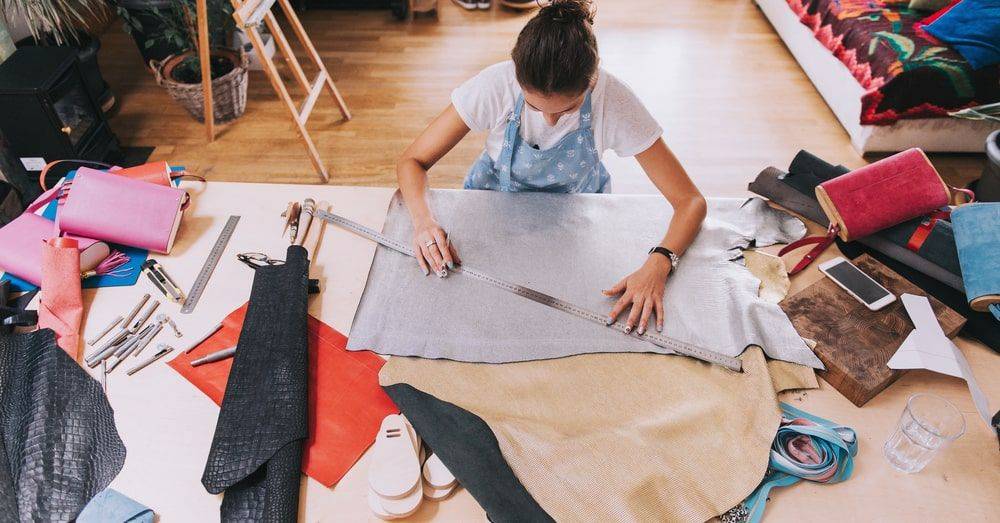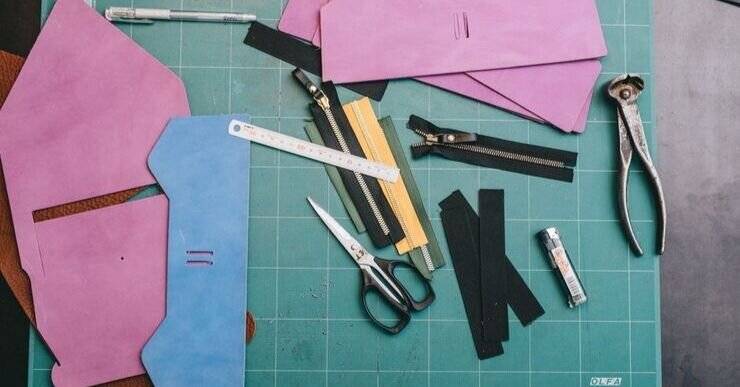10 Hobbies That Make Money and How to Get Started
Tired of working for someone else? Or maybe you have kids and would like to work from home? Join the thousands of people with hobbies that make money.

Ever considered how to start a craft business from the comfort of your own home? Here’s a step by step guide on setting up a profitable online business.

Planning ahead is vital to success when considering how to start a craft business. Without proper preparation new craft businesses can lose sight of the necessary steps to success. The age old cliché really does apply here: failure to plan is planning to fail.
The fantasy is there.
We’ve all ran it through our minds at some point. The dream of doing what we love and making money from it.
If you have that creative spark in you, then it’s likely you’ve at least considered how to start a craft business. Some have a hobby they want to convert to a business. Some just like the idea of being their own boss.
There’s no single type of person that runs their own craft business and that’s the beauty of it.
And with online shopping having become the mainstream it’s now more possible than ever to do from the comfort of your own home. The manufacturing trends for small businesses is real.
Just imagine…
Sitting at home in the evening, doggy (or kitty if you’re more of a cat person) by your side. The embers of the fireplace keeping your face warm. Laptop on hand to check on your orders from the online store.
Maybe you even feel like going out for a pizza.
But…won’t the boss mind?
Oh wait no, relax, everything’s okay… you are the boss.
But that’s unfortunately as far as it goes for most people – a fantasy.
Many never go for it because they know that realizing that dream requires a lot of dedication and hard work.
There are some though that are prepared to go through the motions to make a craft business, they just don’t know how.
Here we’re going to run through the basics of setting up a craft business.
Before we dive in, let’s be real for a second. This is a labour of love we’re talking about, not a get rich quick scheme. It’s a marathon, not a sprint – you should only do it if you’re willing to put your heart into it.
But if you follow through these steps and stick with it, you’ll have a solid foundation to get you started on this journey.
Crafters can find free craft business software online to help them get their business ready for growth.
Okay, so now we want to go ahead and get started.
First thing’s first – an idea.
It’s quite possible you already have a hobby or craft which you could turn into a business, but just don’t know where to start. In this case you’re already one step ahead, and you can skip this section.
But if you don’t currently have a hobby, and really want to be a craft business owner then it’s good to see what’s out there.
You might find there is something which catches your eye and you would love to make a business out of.
Thankfully, there’s endless amounts of crafts you can sell in an online shop, from the comfort of your own home.
You can go as simple as T-shirt printing to the complex designs of handcrafted furniture to fine wines and organic shampoos. Yes, you can make your own organic shampoo, and it’s not as hard as you might think.
The options already there are so vast, we even made a list that you can check out for more ideas, including the most profitable crafts. So, you can just choose which ever one catches your eye and make it your own.
Of course, it’s important that you care about what you make and want to sell.
There’s no point selling the best selling crafts in the world if you have zero passion for them. Running a craft business is no walk in the park, and your soul needs to be in it, if you want to be successful.
But if an idea gets your heart racing – that’s the one.

So, you got an idea for what you want to make.
Now what?
Well give it a go!
Make your product in the cosy walls of your home. Take your time here, there’s no point rushing into things if you haven’t got anything worth selling.
Spend time getting a feel for your product. Think about if from every angle that comes to you. There really are no silly questions to ask yourself here.
If you’re going to become a candle manufacturer, then sit at the dining table with a plate of hot food and consider…
At this point go check that the kitchen isn’t on fire, and then sit back down and consider more questions.
Really — this part is vital, because now you can form a vision in your head. You’ll probably find all this potential swimming around in your imagination.
It’s daunting sure, but it’s also an exciting moment!
Now take that energy and form a plan.
Grab a pen, sit down and write down everything that comes to your head on how you’re going to turn your hobby into a business.
Get familiar with the basics of setting up a business in your country. Every place has its own rules, but honestly it’s a lot less scary than you might think.
A lot of people never set up their business because of this stuff – it’s the hurdle of death.
Take your time and step over it, one leg at a time.
Because once you get over that initial fear you will be miles ahead of anyone else who has ever considered starting their own craft business.

When starting your craft business, craft fairs are a great opportunity to get to your name out there and make those all-important personal connections.
Right, so you got the idea, and now you even got a plan.
So, what’s next?
Time for a name I say.
Well, not just a name actually. If you asked enough of the right questions in the plan, then you might already have an idea of what kind of image you want to portray to the world.
And that’s important, because any seller knows getting people to your stall is half the battle.
If you haven’t asked yourself these questions, then probably best to take a step back and get to know your customers. Do some online research and look at potential competitors.
This isn’t just about the name. It’s about your image and brand. Knowing your customers.
In general though, people who buy crafts do so for two main reasons:
Love of craft production is obvious.
But what’s underneath that is the personal connection to the manufacturer that gets people to part ways with their hard-earned cash.
The feeling they are buying something which has been made with heart and soul. They want to have something in their hands that hasn’t just been mass produced in a factory in China, with only money in mind.
So, it’s important to get that across to your customers. You’re making what you want, and you care about it.
That’s why so many sellers of crafts like to put their own names, or even places of origin in their business name.
Other businesses have gotten real creative and free, because why not?
Think about how the name is going to read for someone who has never heard of your store before.
Consider some of these questions:
What does reading it make you think of?
What message does it give?
Is it easy to pronounce?
Does it roll off the tongue?
Is it recognisable? Short? Attention grabbing?
Ultimately, you want the name to reflect the image you want to portray to your customer AND be memorable at the same time.
Here’s a list of a few of our favourite Shopify store names that have all these elements:
Of course, there are no precise rules to follow with choosing a name, and honestly the best place to start is yourself.
Close your eyes for a few minutes. Let your thoughts rest. And then just start to feel out the words and images that come to you as you channel your craft.
Might seem ridiculous, but hey, you got nothing to lose.
If nothing does come to you though there’s some craft business name generators out there which can come up with some gems of their own.
Even Shopify has its own you can try.
Don’t get stuck here though.
If it’s taking you for ever to come up with a name, then just go with something that is acceptable and move on.
You can change the name later down the line, because the important thing here is to keep that momentum!

There are so many avenues and places to sell your crafts to the world.
But before you go off exploring you need to set up your online store.
Your online store is what is going to allow you to sit at the dining table and become your own boss.
Plenty of options to choose from these days, and a great one to go with is Shopify. They have all kinds designs and themes ready to have your store good to go on day one.
Believe me too, the feeling you get when your website is up in all its glory is a special one indeed.
Not that you should stop there. There’s a whole array of other online channels to sell your items through: Amazon, Etsy, Ebay, Bonanza etc.
And having stores on different platforms gives you access to different kinds of people and customers.
Look at like bonus potential.
So, we got the products and the store(s) ready. All we need now are the customers.
There’s no doubt that the first customers are the hardest to get. They don’t know you or your products quite yet, but remember this is a marathon, not a 100 metre sprint.
Start off with who you know, the people around you: friends, family and acquaintances.
They can quickly become your strongest ambassadors and provide critical feedback. Plus, soon enough, you could find yourself with orders coming in from friends of friends.
Once your close circle is in the bag, you can start to draw those all-important online customers.
There’s loads of ways you can promote your online store in the virtual world.
You can connect with local social media players and use influencer marketing to get your name out there. Some of them will ask for money, but others will just do it if they really like your product.
Another route is to collect email addresses from those who buy your product and then start sending them newsletters. Let them know what’s going on with the store, or if you have any products on sale.
This is also a great way to keep connected with your audience. You can give them little tips and tricks, educate them about your product and even have a little bit of fun.
Just make sure you don’t overdo it. That could drive some of your customers away.
So what else can you do?
Okay, here’s a radical idea.
But I warn you, it does involve you leaving the house a bit.
It’s called…the real world.
Yup, there are places out there in the real world where business sell their crafts in person.
Now this isn’t something you have to do forever. But it’s a great way to get your name out there and allow people to start making that all important personal connection.
Start by mentioning your product to your friends, family and neighbours.
Then you can move onto the classics:
Take an assortment of your products, high and low value, and get talking to people.
They can get the personal touch first hand, and even if they don’t buy, they may have nice things to say about you to other potential customers.
Soon enough you’ll be getting orders coming through from your online store.
All that hard work you put in now feels like nostalgic memory of the past.
“How to start a craft business” is no more.
Time to sit back with a cup of hot coffee and listen to the evening radio.
Bask in the knowledge that you have turned your hobby and passion into a profitable business. The dream has become a reality.
You are your own boss, and now you can reap the rewards of something you built with your own blood, sweat and tears.
But don’t get too comfortable.
Because now, as the orders start rolling and the business grows, you need to make sure you keep on top of it.
You can start with pen, paper and a spreadsheet at first. You’ll probably need a manufacturers inventory spreadsheet template too.
It’s scary though how quickly things can get out of control if you don’t manage your inventory and processes. Especially if more people and products get involved.
That’s why it’s important to make sure you have the supporting tools and software to keep you on track.Smart Manufacturing Software is one of those that helps grow your online craft business by keeping all those tricky moving parts in check.
Then as the journey really starts, you can keep your gaze on the horizon without having to worry so much about the running of a successful, growing craft business.